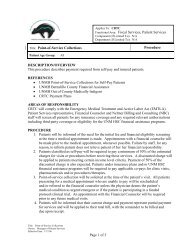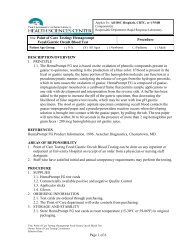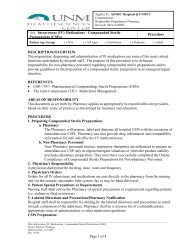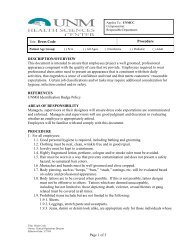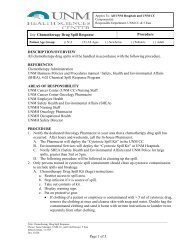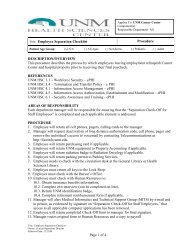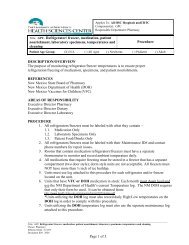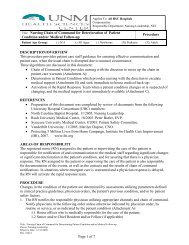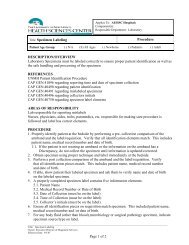Page 1 of 25 DESCRIPTION/OVERVIEW The purpose of this ...
Page 1 of 25 DESCRIPTION/OVERVIEW The purpose of this ...
Page 1 of 25 DESCRIPTION/OVERVIEW The purpose of this ...
You also want an ePaper? Increase the reach of your titles
YUMPU automatically turns print PDFs into web optimized ePapers that Google loves.
forceps for the tip. Your gloved hand may be used to hold the catheter hub while placing it<br />
on one end <strong>of</strong> the tape measure. Do NOT touch the catheter with your gloves as the powder<br />
from the gloves may precipitate a sterile phlebitis.<br />
13. Draw up ten to twenty milliliters <strong>of</strong> 0.9% NaCl. Flush the catheter before adjusting the<br />
guide-wire. Examine the catheter for any perforations other than at the tip. Withdraw the<br />
guide-wire to the length <strong>of</strong> the catheter plus one additional inch or two additional<br />
centimeters. At the same time, pull the wire down at a firm angle against the hub. This will<br />
cause the wire to curl for easier manipulation.<br />
14. <strong>The</strong> catheter insertion technique is per the manufacturer recommendations (see LAC Tray<br />
insert). <strong>The</strong> catheter is trimmed straight across. Do not cut the guide-wire. Under NO<br />
circumstances should a damaged guide-wire be used. If the guide-wire is damaged, discard<br />
the catheter/guide-wire unit.<br />
15. Discard gloves and apply the tourniquet. Don a new pair <strong>of</strong> sterile gloves. Apply the 4X4<br />
gauze over the tourniquet end to allow the nurse to release the tourniquet as needed in a<br />
sterile manner.<br />
16. Perform the veni-puncture with the needle/introducer unit at a shallow angle (approximately<br />
twenty degrees). Note that the tip <strong>of</strong> the needle may be in the vein while the shorter<br />
introducer is not. At <strong>this</strong> point, if the needle is removed or if the cannula is pushed forward,<br />
the cannula will be positioned outside the vein. After obtaining a blood return, lower the<br />
angle <strong>of</strong> the needle/introducer unit making it more parallel to the vein. Advance the unit 1/4<br />
to 1/2 inch into the vein and then advance the introducer while holding the needle in position.<br />
<strong>The</strong> tourniquet may be released at <strong>this</strong> point and the needle safely withdrawn and placed in<br />
the tray. In some patients, it may be necessary to maintain the tourniquet until the catheter<br />
has been advanced several inches.<br />
17. Using the forceps, grasp the catheter approximately one centimeter from the catheter tip.<br />
Advance it in small sections through the introducer. Work quickly to minimize blood loss.<br />
Do not force the catheter if resistance is met as <strong>this</strong> could result in vein or catheter damage.<br />
18. If central placement is desired, have the patient turn his head away from the nurse and tuck<br />
the chin to the chest. This will assist the catheter to move into the proper position.<br />
19. When three inches <strong>of</strong> the catheter remains exposed, withdraw the introducer using the<br />
breakaway technique. Take great care to avoid splitting the introducer while still in the vein.<br />
Advance the catheter to leave one to two centimeters exposed.<br />
20. Withdraw the guide-wire with one hand using a gentle pulling action while stabilizing the<br />
hub with the other hand. Wrapping the guide-wire around a finger will provide steady<br />
tension.<br />
21. Aspirate for a blood return then flush with twenty milliliters <strong>of</strong> 0.9% NaCl. Follow-up with<br />
the 100 units/milliliter Heparin flush.<br />
_________________________________________________________________________________________________________________<br />
Title: Venous Access Device<br />
Owner: Clinical Education Department<br />
Effective Date: 07/27/05<br />
<strong>Page</strong> 8 <strong>of</strong> <strong>25</strong>



